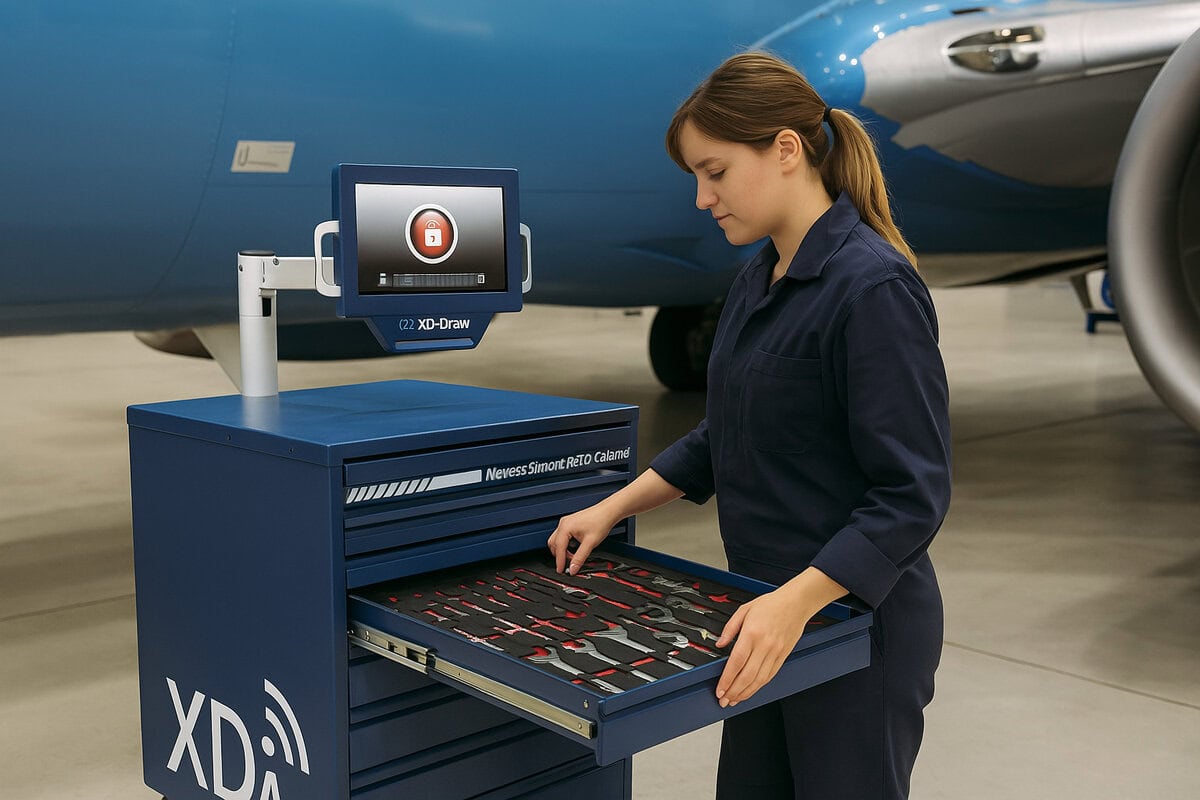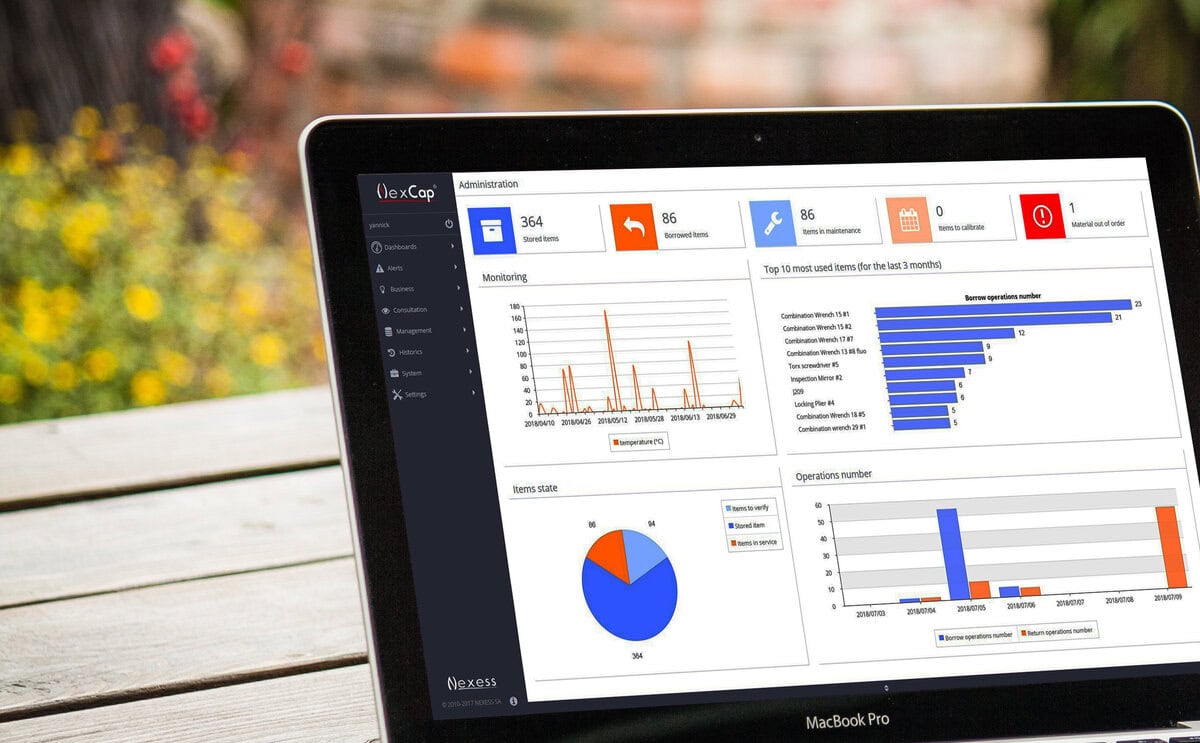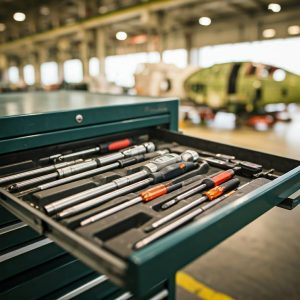In today’s fast-paced industrial landscape, the need for accurate and reliable tool tracking is more critical than ever. Traditional manual methods, such as sign-in/sign-out logs and visual checks, often lead to errors and inefficiencies.
RFID tool control solutions provide a seamless and transparent system that automates tracking, ensuring all tools are accounted for. This improves operational efficiency, safety, compliance, and overall productivity.
Whether managing a small workshop or a large facility, RFID systems can be customized to meet specific needs. They integrate with shadow boards, tool cribs, and automated storage cabinets to deliver a comprehensive tool management solution.
In this blog post, we will talk about the critical role of RFID in modern tool management, what are the key elements composing a RFID tool control solution and how to implement it. Ready?
The Crucial Role of RFID in Modern Tool Management
Understanding RFID Technology
RFID technology plays a pivotal role in modern tool management by leveraging its unique capabilities to identify, track, and manage tools efficiently. At the heart of RFID technology is the interaction between RFID tags and readers. In a tool management context, RFID tags are attached to tools and equipment, while RFID readers are strategically placed in locations such as tool cribs, storage cabinets, and workstations.
When a tool comes within the reader’s range, the tag is activated and transmits its unique identifier back to the reader. The reader then sends this data to the host system for processing and tracking.
Benefits of RFID in Tool Management
The integration of RFID technology in tool management offers several significant benefits. One of the most critical advantages is the enhancement of operational efficiency. With RFID, the manual process of tracking tools is automated, reducing the time spent on inventory checks and minimizing the likelihood of human error.
This real-time tracking capability ensures that tools are always accounted for, which is especially important in industries such as MRO (Maintenance Repair and Overhaull), where tool misplacement can lead to costly delays and safety risks.
Another key benefit is improved security and accountability. RFID systems can be configured to alert management when a tool is removed from or returned to a designated area, ensuring that all tools are properly checked out and returned. This not only prevents theft but also helps maintain compliance with regulatory requirements and internal policies.
Additionally, the automated issue and return process streamlines workflows, allowing workers to focus more on their tasks rather than on managing tools.
RFID technology also enhances safety by ensuring that the right tools are used for the right jobs. By tracking tool usage and location, maintenance schedules can be optimized, ensuring tools are in good working condition before being issued to workers. This proactive approach helps prevent accidents and downtime caused by faulty or missing tools.
Furthermore, RFID systems provide valuable insights through data analytics. The host system can generate reports on tool usage patterns, tool availability, and maintenance needs. These reports can be used to optimize tool inventory, reduce costs, and improve overall operational efficiency.
This data-driven approach enables organizations to make informed decisions and continuously improve their tool management practices.
Key Components of RFID Tool Control Systems
Tags and Readers
At the core of any RFID tool control system are the RFID tags and readers. RFID tags are small devices attached to tools and equipment, each containing a unique identification number stored on an embedded microchip. These tags can be passive, semi-passive, or active, each offering distinct advantages and suitability for different environments.
Passive tags, for instance, are the most commonly used due to their cost-effectiveness and low maintenance, as they derive their power from the radio signals transmitted by the RFID readers.
The RFID readers, also known as interrogators, play an important role in reading and writing data to these tags. Readers come in various form factors, including fixed and handheld models.
Fixed readers are often placed at strategic locations such as tool cribs, storage cabinets, and workstations, while handheld readers provide flexibility for on-the-go audits and tracking in areas without fixed infrastructure. These readers perform air interface functions, manage anti-collision protocols, and communicate with the host system to update the tool inventory in real-time.
The antenna is another critical component, often integrated into the reader or attached separately. The antenna transmits the reader’s power and commands to the tags and receives data back, ensuring efficient communication between the tags and the reader.
The design and placement of the antenna are important, as they can affect the read range and performance of the system, especially in environments with metal or aqueous materials.
Software Integration
Software integration is the backbone of an RFID tool control system, enabling the seamless flow of data between the readers, tags, and the management system. The middleware software manages hardware devices, communicates between readers and business applications, and performs functions such as data conversion, filtering, and distribution. This software ensures that the data collected from the tags is accurately transferred to the system, where it can be processed and analyzed.
The asset tracking software is a scalable digital platform that organizes all the information conveyed by the RFID tags. It supports multiple users with tiered access, allowing different levels of personnel to check tools in and out while maintaining administrative control. Cloud-based software with offline capabilities is particularly beneficial, as it ensures data access whether employees are in the field or at the office, with or without an internet connection.
Features like configurable reporting help in visualizing data by categories such as location, tool type, and employee, facilitating more informed decision-making.
In addition, the software often includes features for predictive and preventive maintenance by tracking tool usage, lifecycle, and calibration schedules. This integration with maintenance software enhances planning, minimizes unplanned downtime, and ensures operational efficiency. The software also logs every step, action, and data exchange with date and time stamps, which is valuable for quality control and process verification.
Implementing RFID Tool Control in Various Industries
Manufacturing and Automotive
In the manufacturing and automotive sectors, RFID tool control systems have become indispensable for optimizing production processes and asset management. In automotive manufacturing, RFID technology is extensively used to track and manage parts and assemblies throughout the production process.
By attaching RFID tags to each component, manufacturers can monitor the movement and status of these components in real-time, ensuring timely delivery and reducing errors. This real-time tracking also enables the automatic updating of inventory information, preventing stock-outs and overstocking, and streamlining the supply chain.
RFID tool control also plays a significant role in tool management within these industries. By automating inventory management, tools are quickly localized, and their availability is increased.
This prevents tools from being misplaced or stolen, reducing downtime and increasing overall productivity. RFID systems are widely implemented to optimize asset management and equipment tracking, resulting in significant reductions in tool idleness and operating costs.
In addition, RFID technology enhances quality control by monitoring the production process in real time. It allows for the swift identification of defective parts and the tracing of their production history, which is critical for maintaining high-quality standards and compliance with regulatory requirements. This real-time feedback mechanism enables production teams to respond quickly to quality issues, adjusting the process promptly to ensure each link meets quality standards.
Aerospace and Construction
In the aerospace and construction industries, RFID tool control systems offer similar benefits but are tailored to the unique challenges of these sectors. In aerospace, RFID technology is used to track and manage high-value components and equipment, ensuring that all items are accurately accounted for and maintained. This is particularly important for monitoring maintenance schedules and ensuring compliance with stringent quality and safety standards.
RFID tags can be attached to critical components, allowing for real-time tracking and status updates, which helps in preventing errors and ensuring that all parts meet the required specifications.
In the construction industry, RFID tool control is essential for managing the vast array of tools and equipment used on site. RFID tags can be attached to tools, equipment, and even materials, enabling real-time tracking and inventory management.
This helps in reducing theft, improving tool availability, and enhancing overall site efficiency. For example, RFID systems can automate the issue and return process of tools, ensuring that workers have the necessary tools at the right time, and that tools are properly maintained and stored when not in use.
Moreover, RFID technology in these industries can be integrated with other systems such as Enterprise Resource Planning (ERP) and project management software, providing a comprehensive view of tool usage, maintenance needs, and inventory levels. This integration enables better planning, reduces manual intervention, and improves the overall efficiency of operations, making it easier to manage complex projects and ensure compliance with industry standards.

An aerospace technician reviews technical blueprints in front of an aircraft during night time maintenance operations.
CONCLUSION
In conclusion, RFID tool control solutions provide a robust and efficient way to manage tools and equipment across various industries. These systems offer real-time visibility, improve inventory management, enhance productivity, and help reduce costs associated with tool loss and theft.
By automating tool tracking, RFID technology ensures tools are always accounted for, minimizing downtime and improving safety and compliance. While there may be initial investment costs and concerns about environmental durability, the long-term benefits of RFID tool tracking — such as improved efficiency, enhanced security, and better maintenance scheduling — make it a valuable asset for any organization.
Embrace RFID technology today to transform your tool management processes and drive operational excellence.
FAQ
Yes, automated tool control systems offer a strong return on investment (ROI) by reducing tool loss, minimizing downtime, and improving operational efficiency. They streamline inventory management, enhance compliance, and lower labor costs related to manual tracking. Over time, these benefits translate into significant cost savings and increased productivity across maintenance operations.
The USAF Tool Control Program is designed to prevent Foreign Object Damage (FOD) to aircraft and equipment, reduce tool replacement costs, and ensure efficient tool access. It includes the following key practices:
-
Designated tool control custodians
-
Regular inventories
-
Strict accountability procedures, including issuance and return forms
-
Marked tools for identification and tracking
-
Use of accountability systems to monitor tool movement
The program also encompasses inspection procedures, maintenance tracking, and control of personal protective equipment and consumables.
The term control tool varies by context:
-
Network management: A control tool is a software interface allowing users to perform actions on devices, such as tagging, controlling, or isolating equipment.
-
Workshop or asset management: Control tools refer to systems or software used to manage and track tools and equipment, promoting efficiency and safety.
-
Industrial control systems: These tools are part of systems that manage or regulate the behavior of other devices, often using control loops.


 Français
Français







